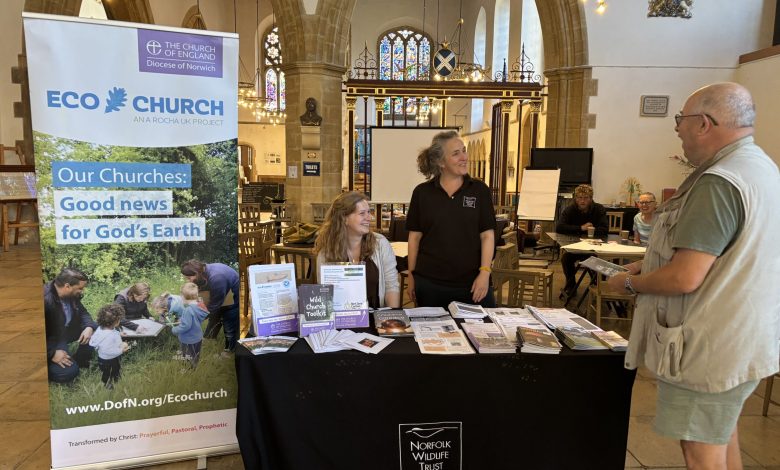Holy Habitats – a conversation on enhancing wildlife in our churchyards

As the world marks the Season of Creation, a unique gathering took place in Great Yarmouth Minster, bringing together individuals passionate about preserving the natural beauty of churchyards. The second of three “listening workshops” aimed to share the triumphs and challenges of improving biodiversity in these sacred spaces. Norfolk, with its stunning churches and 650 churchyards, is a haven for wildlife, and the event emphasized the importance of these areas as undisturbed grasslands in the parish. The partnership between Norfolk Wildlife Trust and the Diocese of Norwich has been instrumental in promoting the Churchyard Conservation scheme, providing expert advice to communities managing their churchyards with wildlife in mind. By working together, they have been able to make a significant impact on the conservation of these vital habitats.
The workshop was attended by over 25 people from various parishes, including North Walsham and Carlton Colville, who came together to share their experiences and challenges in maintaining their churchyards. The event began with each participant writing down three words to describe their parish churchyard, followed by discussion groups that tackled six different questions. The groups were determined by the roll of a dice, adding a touch of playfulness to the proceedings. The final plenary session focused on challenges and hopes, and the room was filled with a sense of camaraderie as people shared their successes and difficulties. The atmosphere was lively, with participants engaging in thoughtful discussions and sharing their stories. The workshop provided a platform for individuals to connect with like-minded people, fostering a sense of community and collaboration.
The discussions highlighted several key points, including the need to manage expectations within the local community. Many people still envision a “neat and tidy” churchyard, which can be at odds with the goal of preserving biodiversity. To address this, participants emphasized the importance of education and good communication. By explaining the reasons behind the conservation efforts and having clear signage, articles, and social media posts, communities can raise awareness and build support for their initiatives. Additionally, involving the local community in the conservation process can be a powerful way to build momentum and foster a sense of ownership. For instance, hosting events like “rake and bakes” – where volunteers can work together on conservation projects while enjoying food and company – can be an effective way to engage the community and promote the importance of conservation.
Another challenge faced by many parishes is the need for more volunteers and funding. To address this, participants suggested working with local conservation groups, inviting community involvement, and seeking grants. By sharing resources and collaborating with other organizations, parishes can amplify their impact and achieve more than they could alone. Developing a land management plan and maintaining it is also crucial, and participants recommended getting surveys done or updated by Norfolk or Suffolk Wildlife Trust. The Caring for God’s Acre activity pack and annual citizen science events, such as Churches Count on Nature, can provide valuable guidance and support. By sharing progress and the reasons behind their conservation efforts, parishes can inspire others and build a sense of collective purpose.
The workshop was a resounding success, with participants leaving feeling inspired and motivated to take action. The event demonstrated the power of collaboration and the importance of community involvement in conservation efforts. As one participant noted, “It’s not just about the churchyard; it’s about the entire community coming together to protect the natural world.” The final workshop, scheduled for October 21 at King’s Lynn Minster, is open to all and provides an opportunity for others to join the conversation and be a part of this vital conservation effort. By working together, we can make a tangible difference in preserving the beauty and biodiversity of our churchyards, and ultimately, our planet.
The Season of Creation is a timely reminder of our responsibility to care for the natural world. As we reflect on our relationship with the environment, we are called to consider our impact on the world around us. The churchyard conservation effort is a testament to the power of collective action and the importance of preserving the beauty and wonder of nature. By supporting this initiative and working together, we can create a better future for generations to come. The story of the churchyard conservation effort is one of hope and resilience, demonstrating that even in the face of challenges, we can come together to achieve great things. As we look to the future, we are reminded that every small action counts, and that collectively, we can make a profound difference in protecting the natural world.








